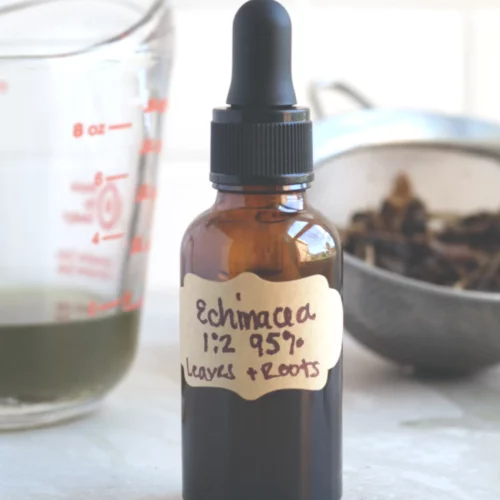
Echinacea Tincture
Echinacea tincture can help prevent or shorten the duration of colds and other respiratory infections. This recipe includes fresh echinacea roots, but you can add in the fresh leaves, stems, or seeds.
Equipment
- Sterilized glass jar with a tight-fitting lid
- Cheesecloth or a fine-mesh strainer
- Funnel
- Amber glass dropper bottle
Ingredients
- 1 part fresh Echinacea roots
- 2 parts high-proof alcohol such as vodka or grain alcohol
Instructions
- Harvest fresh Echinacea roots in the late Fall. Choose plants that are at least 2 years old. Scrub the roots clean with cool water and chop into small pieces soon after harvesting.
- Sterilize your mason jar and make sure it’s completely dry before adding the ingredients. Add the roots and alcohol to the sterilized jar. Make sure the plant material is covered completely. Top off with a little more alcohol, as needed. The ratio of alcohol to Echinacea should be roughly 2:1 (for example, 2 cups alcohol to 1 cup roots).
- Place the jar in a cool, dark place and let it sit for about 4-6 weeks. Shake the jar once a day to mix everything around. Don't forget to label it!
- After four to six weeks, strain the tincture using a cheesecloth and a fine-mesh strainer. Squeeze the roots in the cheesecloth to extract all of the liquid. Use a funnel to transfer the tincture into amber glass dropper bottles. The amber glass will protect the tincture from light and help to preserve its potency.
- Label the tincture with the date and the name of the herb. Store it in a cool, dark place. A tincture can last for several years if stored properly.
Notes
It’s always best to consult with a qualified healthcare practitioner or herbalist who can help you determine the appropriate dosage based on your individual needs. However, here are some general guidelines for adults using an Echinacea tincture:
Immune Support: 1/2 teaspoon - 1 teaspoon three times a day at the onset of symptoms and for the duration of the illness.
Note 1: This information is general and for educational purposes only. Your personal health and dosing should be determined by you and your healthcare provider.
Note 2: Echinacea works best taken short-term during the illness. I do not recommend taking it long-term
Echinacea is generally considered safe for most people when consumed in reasonable amounts, but there are a few things to keep in mind:
- Allergies: People allergic to plants in the daisy family (Asteraceae), such as ragweed, may experience allergic reactions to Echinacea.
- Autoimmune Conditions: People with autoimmune conditions should use caution with Echinacea, as it stimulates immune activity.
- Pregnancy and Nursing: Consult a healthcare provider before using Echinacea if pregnant or breastfeeding.